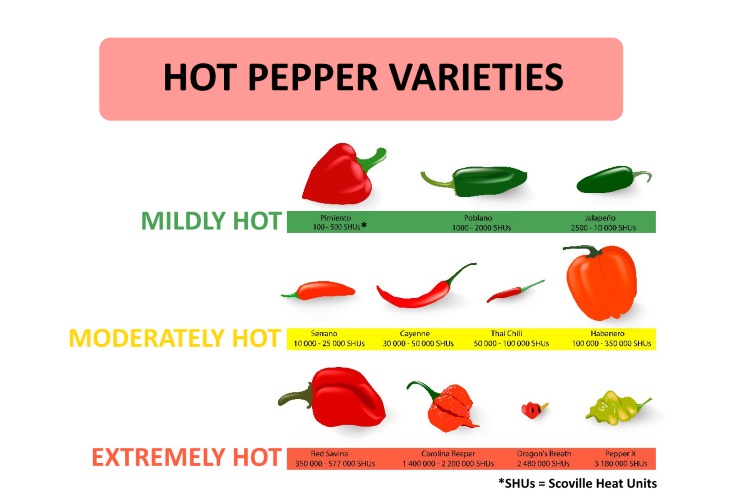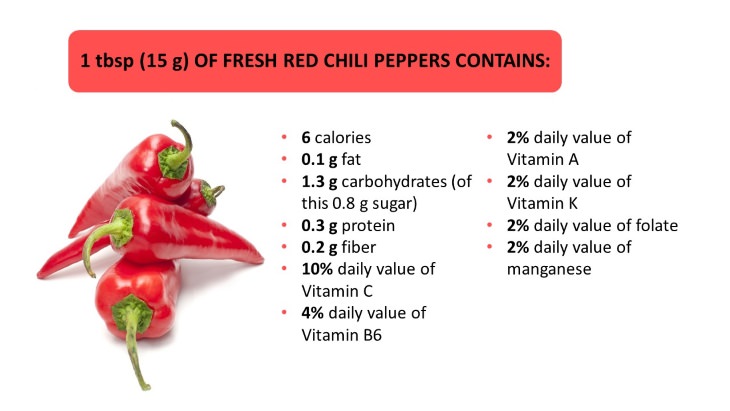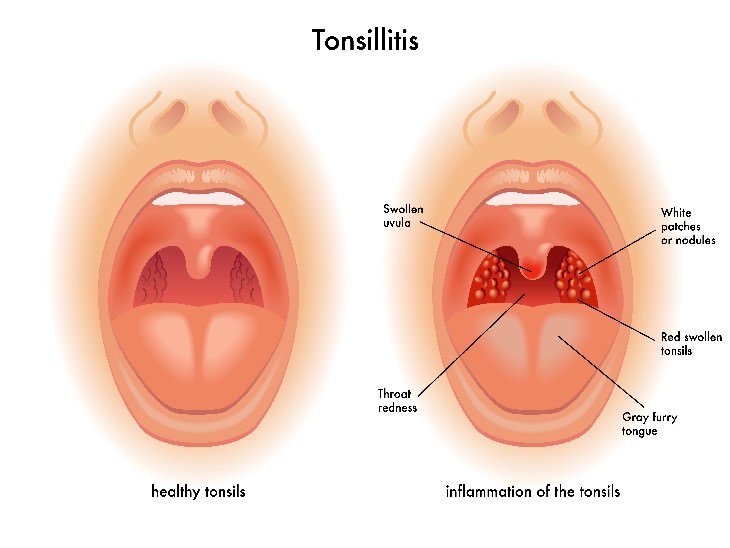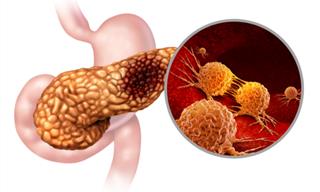Types Of Chili Peppers
Chili peppers come in all shapes, sizes and spice concentrations, with the pimiento chili having a mild and pleasant flavor and habanero peppers being significantly spicier. As for the spiciest varieties, they often come with a dangerous-sounding name, like the Carolina Reaper, Dragon’s Breath or Pepper X, which is a good thing, as it urges beginners to stay away from these fiery peppers.
This wide variation in spiciness is not surprising, by the way, as in Spanish, the word ‘chile’ can be used to name any pepper, even sweet bell peppers. The chart below showcases some popular varieties of hot peppers categorized by their spiciness.
Nutritional Value and Benefits
Different types of chili peppers have different combinations and quantities of nutrients, but the key mutual nutrient found in all of them is a bioactive compound called capsaicin, which is responsible for the spicy taste and several health effects of these peppers.
Similarly, all chili peppers are very low in calories but relatively high in fiber and plant nutrients, vitamins and minerals, which makes it a valuable addition to your diet. Below you can find a table summarizing the nutritional value of fresh chili peppers.
Do keep in mind that, in the majority of cases, hot peppers are consumed in low quantities and are used as spices or condiments, so you’re not likely to get a lot of macronutrients from them, but they do pack a punch in the vitamin department. For example, chili peppers contain 3 times the amount of vitamin C compared to oranges.
But probably most importantly, hot peppers contain unique phytochemicals that are responsible for the majority of their positive health effects. These include:
- Capsaicin. This is the compound that makes peppers spicy. It has been studied the most and is linked to the majority of hot peppers’ health benefits.
- Capsanthin is an antioxidant that also makes peppers red. The antioxidant properties of this compound may be able to fight cancer.
- Lutein may improve eyesight, but its levels are greatly decreased as the pepper ripens.
- Violaxanthin is another antioxidant that’s responsible for the yellow pigment of peppers.
- Sinapic and ferulic acid. These antioxidants are linked to anti-aging benefits and can prevent the development of chronic diseases.
Given the abundance of vitamins and antioxidants in chilies, it’s no wonder they are associated, both traditionally and in medical science, with several health benefits. Here are the main ones:
1. Pain relief
One of the phytochemicals contained in hot peppers, capsaicin, has a unique property of binding to pain receptors in the brain, causing you to feel a burning sensation, but without any adverse effects on the body.
Since our brain can process only so many kinds of pain at the same time, it is possible to dull the pain you’re experiencing by eating spicy foods or using medical aids that contain capsaicin. By doing so, you will trick your brain into being less sensitive to pain.
Topical patches and creams containing capsaicin, for example, were shown to decrease pain linked to arthritis, joint, and muscle pain, as well as nerve damage linked to diabetes. Capsaicin nasal sprays, on the other hand, are also used to deal with migraines. Finally, a study has shown that heartburn can also be relieved by ingesting 2.5 g of chili peppers every day.
2. Weight loss
Chili peppers are a multitasker when it comes to weight loss management, with several studies showing that it can not only suppress one’s appetite but also increase fat burning in both men and women.
And while most of these studies do suggest that the best results were achieved in participants who combined exercise and smart diet choices with chili peppers, they do conclude that a daily intake of hot peppers or a capsaicin supplement can boost one’s metabolism and promote weight loss.
3. Longevity
If you eat chili peppers at least once a month, you are more likely to live longer, at least that’s what a large scale study found. More precisely, individuals who ate at least 1 red chili pepper (dry or fresh) a month for 20 years had a 13% lower chance of death compared to people who didn’t.
It seems like the variety of nutrients contained in these spicy peppers might help fight chronic inflammation and obesity, in the long run.
4. Stomach ulcers
One of the leading causes of the development of stomach ulcers is alcohol, NSAID pain relievers and a strain of bacteria called H. pylori. Several studies found that, contrary to popular belief, the anti-inflammatory and antibacterial properties of hot peppers, and particularly capsaicin, helped prevent the development of stomach ulcers among people with high counts of H. pylori in their stomachs, as well as other risk factors.
5. Relieve nasal congestion
Some people experience what is called non-allergic rhinitis, which is when you have a runny or stuffed-up nose that is not due to a cold or allergy. Oftentimes, people with this condition benefit from capsaicin nasal drops. These drops may cause a burning sensation in your nasal cavity at first, but they may relieve you of nasal congestion for weeks or even months.
6. Antibacterial properties
People have been using spices, especially pungent ones, like chili, to prevent food from spoiling for thousands of years. This traditional use is certainly supported by science, with chili, in particular, having been proven to possess antibacterial and antifungal properties.
For one, it was found that chili extract can even prevent cholera bacteria from producing toxins. Some scientists even suggest using chili extract as a natural preservative. Apart from preventing food poisoning, however, some studies even used chili extract to treat streptococcus-induced throat infections, chlamydia, and tooth decay. It needs to be noted, however, that all these studies looked at the effect of chili extract, and not whole chili peppers, on these conditions.
7. Help Regulate Blood Pressure

The final advantage of chili peppers is their capability to regulate blood pressure and blood sugar. More specifically, chili peppers can help normalize cholesterol levels, at least in animal models. Apart from that, one study suggested that eating 5 g of chilies before a meal high in carbohydrates can help prevent sugar spikes, which means that chili peppers can be beneficial for your heart health and diabetes prevention, although we must point out that more evidence is necessary to back that claim.
As you can see, chili peppers are an excellent addition to one’s diet, with even small amounts of this spice being able to do wonderful things to our bodies. Still, it needs to be mentioned that not all people can tolerate spicy food, and personal sensitivity to spice can result in strong burning sensations, indigestion, and diarrhea, especially among people who rarely eat spicy food or have bowel conditions, such as IBS.
The bottom line is, if you like spicy peppers, know that they can really improve your health, but if chilies make you suffer and you cannot tolerate the burning sensations, it’s best to avoid them.
 Go to BabaMail
Go to BabaMail































































